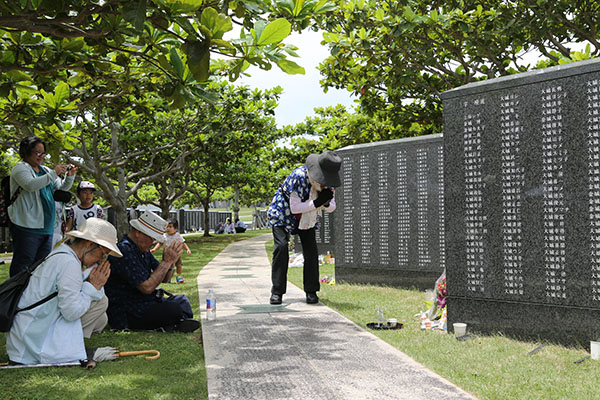Scars spur battle over Okinawa's 'war relics'
By Cai Hong and Shan Yi in Tokyo (China Daily) Updated: 2015-08-12 07:44
|
People gather to pay homage to their relatives at a peace memorial park in Itoman, where rows of stones are engraved with the names of those who died during the Battle of Okinawa in 1945. Photo by Cai Hong / China Daily |
Peace park
Mabuni Hill in Itoman, a city in south Okinawa, where the last battle was fought on June 23, 1945, has been turned into a peace memorial park with rows of stones engraved with the names of all the war dead, be they Japanese or US.
An annual memorial service is held on June 23 in the park, and Japan's prime ministers have shown up. It was a scorching hot day when people gathered this year to pay homage to their relatives who died.
The ceremony turned rowdy when protesters told Prime Minister Shinzo Abe to "go home".
Their anger stems from the fact that 70 years after the Battle of Okinawa, the prefecture still bears the burden of a large US military presence. At the ceremony, Okinawa's Governor Takeshi Onaga broke from tradition by reiterating his opposition to the relocation of US Marine Corps Air Station Futenma to Nago in Henoko.
Abe talked with Onaga for only five minutes before returning to Tokyo. In 2013 and last year, he attended the memorial ceremony and chatted with then-governor Hirokazu Nakaima over lunch before heading back to Tokyo.
The political back-and-forth between Okinawa and Tokyo continues, with no real prospect of a breakthrough.
Located south of Kyushu, Okinawa represents just 0.6 percent of Japan's land mass. But 18.3 percent of this 100-kilometer-long prefecture is set aside for US bases that account for 74 percent of US bases in Japan.
Numerous accidents and crimes involving US military personnel have instilled a sense of fear among locals. The 1995 rape of a 12-year-old girl by three servicemen intensified local opposition to the US presence.
Many Okinawans are frustrated by a fate they cannot control.
Initially, Okinawa was to be used as a launchpad for the planned invasion of the Japanese main islands in the closing days of World War II.
Two atomic bombs dropped on Hiroshima and Nagasaki made the invasion unnecessary, leaving a large contingent of US forces stationed on Okinawa with a huge stockpile of military hardware.
Okinawa was put under US administration in line with the San Francisco Peace Treaty that Japan and some Allied countries signed in 1951. The US and Japan inked the Treaty of Mutual Cooperation and Security in 1960, allowing the US to keep forces in Japan.
The end of the war offered local people nothing but frustrations.
The acquisition of the land for bases, which started in 1958, was forced, with the troops brandishing bayonets and bulldozers.





